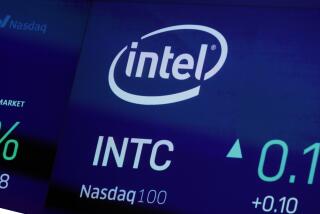AMD-Intel Battle Now Tangled in 2 ‘Webbs’ : Technology: A mis-routed package landed in the hands of Intel. The contents prompted a suit over the trademark for the 386 microprocessor.
- Share via
SAN FRANCISCO — An incredible sequence of events involving a mis-routed express package has led to a new round of lawsuits in the heated dispute between arch-rivals Intel Corp. and Advanced Micro Devices over the rights to build an advanced microprocessor.
Intel and AMD are already fighting it out in several courts over licensing of the technology for Intel’s 80386 microprocessor, the brain inside many advanced personal computers. And the resolution of the dispute could have major implications not only for AMD and Intel but also for personal computer companies that use the chips and for other chip makers that hope to clone it.
As the sole supplier of the popular chip--often just called the 386--Intel is expected to generate nearly $1 billion in revenue from it, with profit margins in the 80% to 90% range. Not surprisingly, several companies, including AMD, have been eager to build 386 clones, and personal computer vendors have encouraged their efforts because they cannot get enough of the chips from Intel.
With two major legal decisions pending, AMD has been coy about its plans to come to market with a 386 clone, although it is widely expected to introduce one soon.
And now, Intel has revealed that it is no longer in doubt about AMD’s 386 efforts: It said it had come into possession of AMD literature about a product line called the AM386, and on the basis of that filed suit Wednesday against AMD for trademark infringement.
Intel says the documents had been sent by express delivery to the Sunnyvale Hilton hotel, intended for an AMD employee named Mike Webb. But it seems that an Intel employee named Mike Webb had also been staying at the hotel, and since both Mike Webbs had already checked out, the hotel forwarded the material--to the wrong Mike Webb.
Intel’s Mike Webb, in turn, passed the documents on to his boss, who turned it over to the Intel legal department, who looked at the first page and found logos and references to the AM386. An Intel spokesman said the package was then sealed, and no one looked through the rest of the material. Intel filed suit against AMD, citing the cover sheet as proof that AMD would use what it claimed as a trademark, the 386 numbers.
AMD spokesman John Greenagel said, however, that it was not clear that the two Mike Webbs had been in the hotel at the same time. “We think there has been some impropriety,” he said, and AMD plans to file a countersuit today charging Intel with “misappropriation and conversion” of AMD property and asking for $10 million in damages.
The latest dispute borders on farce, but there’s nothing funny about the broader legal battle between the two firms. AMD was the authorized second source for the previous generations of Intel microprocessors, the 80286 and the 8086, and it claims that a broad technology-sharing deal with Intel signed in 1982 gives it the rights to the 386 as well.
But Intel, which broke with industry practice when it decided to make the 386 alone without a second source, says AMD did not come up with the comparable products required under the technology deal, and thus Intel has no obligation to share the 386. An arbitrator who is hearing the dispute issued preliminary findings that appear to favor AMD, and a final ruling is expected any day. Intel could be forced to allow AMD to make exact copies of the 386, although few expect that outcome.
In a related action, AMD last year began producing a copy of a different Intel chip that uses Intel’s copyrighted microcode, the instructions written into a microprocessor. Intel sued AMD, maintaining that it had given AMD access to its microcode only for internal purposes, but AMD says that claim is absurd. And analysts say AMD deliberately introduced the chip to resolve the microcode dispute so that it could make the 386.
Making a legal copy of the 386 will be far easier if AMD can use the Intel microcode. A trial in that lawsuit is set for February.
Other chip makers, meanwhile, are trying to figure out ways of making a 386 that isn’t protected by microcode copyrights, patents or the special provisions against copying chip layouts that are contained in the federal Chip Protection Act. Several companies, including Chips & Technologies and two Silicon Valley start-ups--Nextgen Microsystems and Integrated Information Technologies--are expected to soon introduce 386 clones that use several chips to perform the same functions, thus avoiding some of the intellectual property problems.
Analysts say it will be almost impossible for Intel to avoid some kind of clone competition. Eli A. Sayegh, an analyst with S. G. Warburg in San Francisco, says Intel will certainly be hurt, “assuming the clone chips are indeed fully compatible.” He estimates that they could take 20% of the market within two years.
But Intel officials note that the company “is not standing still,” and will continue to improve what is now a 5-year-old product to stay ahead of the competition. “Intel is not nearly as vulnerable as people think,” said Dean McCarron, an analyst with the chip research firm In-Stat Inc.






